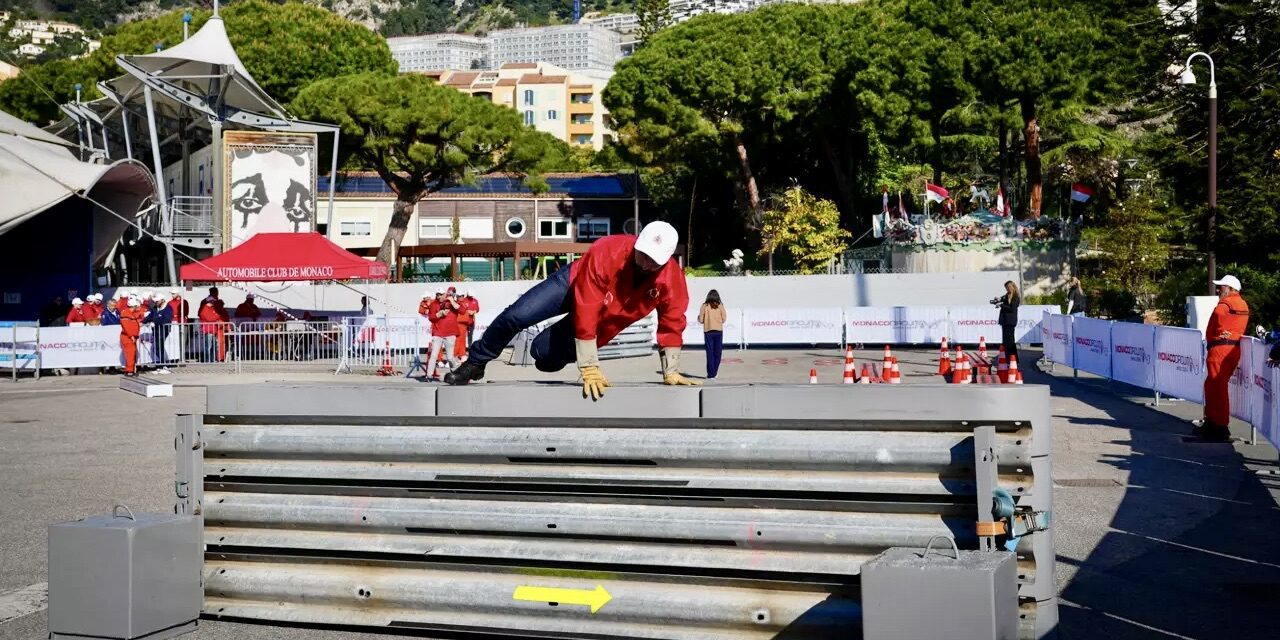With just weeks to go before Monaco hosts its two major motor racing events in May, the Formula E E-Prix and the iconic Formula 1 Grand Prix, the Automobile Club de Monaco (ACM) has put its marshals through their paces in a high-stakes preparation weekend in Fontvieille. And this year, training has been taken to the next level with the addition of new safety and rescue drills to ensure that all hands are ready when the engines roar to life.
Several hundred marshals, both seasoned veterans and new recruits, assembled beneath the Fontvieille marquee for a rigorous series of workshops. The programme, designed to simulate real race-day emergencies, featured 10 demanding modules covering everything from fire suppression and vehicle recovery to first aid and physical fitness.
A standout element of this year’s training was the focus on fire response. Marshals, kitted out in full intervention gear, were drilled on extinguishing blazes involving single-seater race cars. These exercises — conducted under the watchful eyes of Monaco’s fire brigade and punctuated by the overhead thrum of helicopters — tested participants on their speed, teamwork, and ability to act under pressure. The emphasis was clear: one person alone can’t extinguish a fully engulfed car — it takes a coordinated effort.

Nearby, other groups tackled scenarios like vehicle rollovers, car evacuations using cranes, and even stretcher-handling, in collaboration with the Monaco Red Cross. The goal was to prepare marshals for any eventuality during the high-profile events, where swift and seamless interventions are essential.
Fitness assessments also featured prominently. While it wasn’t quite the Olympic Games, candidates were challenged with obstacle courses testing agility, strength, and balance — all necessary to manage the physical demands of marshalling. From balancing on beams to hauling tyres and leaping over barriers, every move was scrutinised.
Beyond the practical drills, marshals also revisited theoretical aspects of their role. Sessions included briefings on electric vehicle risks, reviews of past interventions via video analysis, and flag signalling for newcomers — a mandatory module covering the crucial communication cues used on track.
Each participant — regardless of experience — was assessed across multiple criteria. The scoring was twofold: team members were evaluated on their execution and cooperation, while team leaders were expected to demonstrate leadership and decision-making under pressure. Video footage from the sessions provided further insight for the assessors, helping them make considered decisions about each marshal’s readiness and ideal role.
Recruits’ preferences were taken into account, but final assignments were based on performance, physical suitability, and ability to manage real-world scenarios. Those who struggled with physically demanding tasks could still be directed toward signalling or fire safety duties, where precision and calm count for just as much.
Motivation and psychological resilience were also key factors. Instructors paid close attention to how marshals responded to stress and the unexpected — critical traits when split-second decisions must be made just metres from speeding race cars.
Following two days of intense drills, evaluations will now be compiled and used to determine placements ahead of the general assembly on Thursday, April 17. New marshals will then be introduced to their team leaders, who will begin a mentorship process leading into race weekend. Veteran marshals will largely remain in their established roles unless changes are necessary.
The final preparations will take place at dawn on race days, with all marshals expected to be operational from Saturday, May 3 for the eighth edition of the Monaco E-Prix — the first of the month’s two grand automotive showpieces. With the world watching, there’s no margin for error — and Monaco’s elite marshal corps is getting ready to prove, once again, why it’s considered one of the best in the world.
Images courtesy of Automobile Club de Monaco


